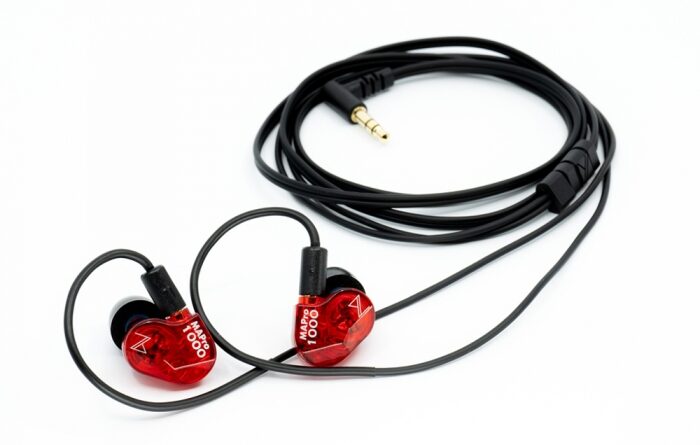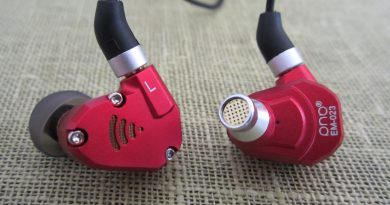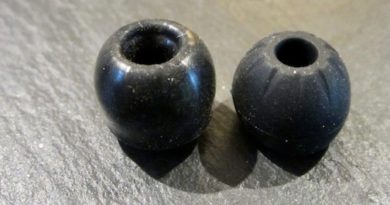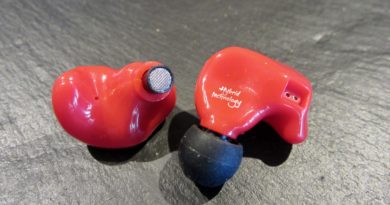Maestraudio MAPro 1000 Review – Intime As Well
I have had these in my pockets for a while now, and their predecessors too. Time has come to share some well deserved notes.
In this Article
Intro: Maestraudio… chi era costui? (*)
Ozeid Co. Ltd is the japanese manufacturer better known for their Intime Acoustics line of IEMs, based on proprietary piezo technology, ceramic drivers, and other unique components. All Intime IEMs share (fat) bullet-shaped housings. When the company eventually ventured into widening its offering with Universal IEM-shaped alternatives, they decided to do so under a separate brand-name: Maestraudio.
Housings shape is the most evident but not the sole difference between Intime and Maestraudio product lines. Another major difference lies in their ceramic drivers design.
Intime models are all built around a number of unique components, the most significant ones arguably being the HDSS internal reflections conditioner, and most of all the proprietary VST (Vertical Support Tweeter) piezo electric ceramic driver. For a wider and deeper description of Intime IEM’s internals you may want to refer to my previous articles about Sora 2, Miyabi, or Sho-DD.
Over time various “generations” of the VST driver have been developed, all however sharing two key aspects: VST is an active component (i.e. it vibrates following the electrical signal coming from the source) and, paired to its companion Dynamic Driver, it is installed coaxially to the main sound propagation direction, which is also the main axis of the bullet-shape housing axis, and ultimately of its output nozzle.
Such assembly choice, so natural in conjunction with cylindrical housings, becomes an obstacle or even a problem inside a Universal IEM shaped housing, and that’s why for Maestraudio’s product line a totally new tweeter driver variant was – once again, internally – developed.
Such new driver is first of all “passive” instead of “active”, i.e., it does not directly receive an electrical signal, rather it vibrates “as a consequence to” air waves produced by its DD companion.
Most importantly, its sound propagation cone is much wider compared to VST’s (132° vs 68°), and that’s key when positioned inside a Universal IEM shaped housing.
In the firm’s own words: “The principle is to irradiate the diaphragm with sound waves from the dynamic driver to induce vibration. This product uses a diaphragm based on red copper, which is often used in wind instruments, and a unique special ceramic coating is applied to the surface to obtain high tones with good grain. This is a new type of passive ceramic coated tweeter that allows sound quality to be controlled by the dimensions, material, and support method of the diaphragm”.
All of the above grants clear meaning to the part’s name: RST (Reactive Sympathetic Tweeter).
Maestraudio product line
Ozeid kicked their Maestraudio adventure off a couple of years ago, and a few models hit the market already.
The very first model was called MA910S, featuring non-replaceable single-ended cabling, smooth yet very technical tuning. It was very quickly followed by MA910SB: same specs as MA910S, but carrying 4.4mm balanced-ended cabling, and a slightly different tuning expressly calibrated to take advantage of balanced connectivity.
The third model – MA910SR – features a removable (hence the -R) cable, adopting pentaconn hoousing connectors in lieu of the more common (and less reliable) MMCX standard.
Another interesting novelty on MA910SR is represented by the housing’s faceplate, which is made in aluminium, instead of plastic as on MA910S/SB. Aluminium transmits vibrations much more easily compared to plastic, which means that on MA910SR (quote) “the amount of sound information transmitted from the faceplate to the inside of the housing is overwhelmingly greater […] [thereby] achieving a sound with more information and higher resolution while maintaining the width of the sound stage” (endquote).
And finally, very recently the MAPro 1000 model was released, featuring a number of further novelties.
The housing shape is totally redesigned on MAPro 1000: instead of a quite generic (“classic”, even), generous sized Universal IEM shape, MAPro 1000 adopt a smaller, more ergonomic “slanted oval” design, aiming at superior comfort over long auditioning sessions, and better passive isolation too.

The RST driver also needed further redesign to optimally match the MAPro 1000 project. The latest release is now smaller: 5.8mm in diameter, down from 9mm. In the company’s words (quote) the new size is to “obtain the dispersion and sound pressure of the high-pitched sounds equivalent to the MA910S series even in a narrow-capacity housing by making full use of acoustic and vibration simulations” (endquote).
Lastly, MAPro 1000 feature removable cabling like MA910SR, but with industry-standard MMCX connectors, and ship with two newly released very interesting eartips sets: silicon based iSep2, evolution of Intime iSep series, and foam based iFep.
All of these models are primarily marketed onto the domestic (japanese) market, but can easily be purchased by international users from Amazon JP, and some other international Amazon sites. They all cost around 55-65€, including international delivery.
Upon initial release, 2 years ago, I purchased a pair of MA910S, and more recently I also got a pair of MAPro 1000, and this story is about the latter, with some added, hopefully relevant comparisons
At-a-glance Card
| PROs | CONs |
| Outstanding technicalities in this price class | Limited stage depth (still above average for price class) |
| Well calibrated W-shaped presentation | Some courage missing on treble tuning |
| Balanced tonality, organic timbre | |
| Very good bass and sub bass | |
| Articulated yet not excessive treble | |
| Small, lightweight, super-comfortable | |
| Very low price, huge value |
Full Device Card
Test setup and preliminary notes
Sources: AudioQuest DragonFly Cobalt / Chord Mojo / E1DA 9038D / Sony WM-1A – Final Type E silicon tips – Stock cable – lossless 16-24/44.1-192 FLAC + DSD 64/128/256 tracks.
I am not writing these articles to help manufacturers promote their products, even less I’m expecting or even accepting compensation when I do. I’m writing exclusively to share my fun – and sometimes my disappointment – about gear that I happen to buy, borrow or somehow receive for audition.
Another crucial fact to note is that I have very sided and circumscribed musical tastes: I almost exclusively listen to jazz, and even more particularly to the strains of post bop, modal, hard bop and avantgarde which developed from the late ’50ies to the late ’70ies. In audio-related terms this implies that I mostly listen to musical situations featuring small or even very small groups playing acoustic instruments, on not big stages.
One of the first direct consequences of the above is that you should not expect me to provide broad information about how a certain product fares with many different musical genres. Oppositely, you should always keep in mind that – different gear treating digital and analog sound in different ways – my evaluations may not, in full or in part, be applicable to your preferred musical genre.
Another consequence is that I build my digital library by painstakingly cherry-pick editions offering the least possible compression and pumped loudness, and the most extended dynamic range. This alone, by the way, makes common music streaming services pretty much useless for me, as they offer almost exclusively the polar opposite. And, again by the way, quite a few of the editions in my library are monoaural.
Additionally: my library includes a significant number of unedited, very high sample rate re-digitisations of vinyl or open-reel tape editions, either dating back to the original day or more recently reissued under specialised labels e.g. Blue Note Tone Poet, Music Matters, Esoteric Jp, Analogue Productions, Impulse! Originals, and such. Oppositely, I could ever find an extremely small number of audible (for my preferences) SACD editions.
For my direct and conclusive experience, virtually none of the above is available on the most common streaming platforms, which makes their offering of high sampling material apriori pointless for my purposes. Quite simply, then, I don’t use streaming services as I find them not up to my requested quality.
My source gear is on its turn selected to grant very extended bandwidth, high reconstruction proweness, uncolored amping. Which in particularly means that TWS and any other form of lossless-based wireless gear is apriori off my selection panel.
And finally, my preferred drivers (ear or headphones) are first and foremost supposed to feature solid note-body timbre, and an as magically centered compromise between fine detail, articulated texturing and microdynamics as their designers can possibly achieve.
In terms of presentation, for IEMs I prefer one in the shape of a DF curve, with some very moderate extra pushup in the midbass. Extra sub-bass enhancement is totally optional, and solely welcome if seriously well controlled. Last octave treble is also welcome from whomever is really able to turn that into further spatial drawing upgrade, all others please abstain.
Signature analysis
Tonality
MAPro 1000 offer a well calibrated W shaped presentation, with a spot on note weight.
The new iSep2 tips are good for the job – better than their previous version insofar as a bit stiffer, now they behave similarly to Acoustune ET-07. That being said, after the usual boring rolling sessions I determined that good ol’ Final Type E tips are further marginally better, especially in the presence section.
Bass
Mid bass has a good level, texture and personality, and always stays under control. Sub bass rumble is definitely there when called for.
Mids
Mids, especially central ones, are bodied and somewhat forward making tenor sax and acoustic guitars relatively more prominent. In spite of this, some last-mile refinement is lacking for MAPro 1000 to be considered particularly good for vocals, especially females, which are a tad flat a unlushy.
Highmids are relatively inoffensive.
Highs
Trebles, light high mids, are also on the polite, almost posh page. Don’t be mislead however: MAPro 1000 still deliver articulated highs, carrying some more than decent energy. There is some very occasional tendency to female voice sibilance, which is reduced by iSep tips and even more by Type E tips.
Technicalities
Soundstage
Soundstage is quite wide, with some depth and good height, which is much more then you normally find on most drivers on this price reference.
Imaging and separation
Imaging is always outstandingly precise. Layering and separation are stunning for this product class, totally commendable indeed.
Driveability
With their high (111dB) sensitivity at a not too low impedance (22 ohm) MAPro 1000 are super easy to drive by pretty much any source.
Physicals
MAPro 1000 wearability is indeed great: they are very cleverly shaped and aptly designed at least for my ears of course.
Extremely lightweight, they practically “disappear” when worn and I can keep them on for hours with zero side effects.
Passive isolation is average.
Specifications (declared)
| Housing | Plastic structure, monitor shape earphone type IEM |
| Driver(s) | 10mm diameter graphene coated dynamic driver x 1 5.8mm diameter RST (Reactive Sympathetic Tweeter) x 1 |
| Connector | MMCX |
| Cable | Approximately 1.2m OFC 4-core wire, with 3.5mm 3-pole L-shaped plug |
| Sensitivity | 111dB |
| Impedance | 22 Ω |
| Frequency Range | 20Hz to 40KHz |
| Accessories and package | iSep02 silicon earpieces (S/MS/M/L), iFep01 foam (S/M/L), carrying pouch |
| MSRP at this post time | 9.999,00 JPY |
Comparisons
As most of my however few readers surely remember I am fond of Watanabe sama’s engineering products, and for this reason I own quite a few Intime IEM models. I’m picking a couple of those as pertinent comparisons to Maestraudio alternatives, using approximate price point as the main selection criterion. Both mentioned models are, again, easily available on Amazon JP, even internationally.
For my direct experience no chi-fi origin similar priced IEMs come close enough to this lot in terms of sound quality – with particular reference to timbre and technicalities – to deserve a mention within this section.
Maestraudio MA910S
General tonality is very similar, bass tones in particular are equivalently good compared to MAPro 1000. What’s lacking on MA910S is some airiness in the treble, and depth in the stage – which is wide, but pretty much limited to the X axis. Imaging stays great, but layering and separation are not on the same page compared to MAPro 1000.
MA910S has “Universal IEM” shaped housings: their wearability is good for me, yet indeed MAPro 1000’s more ergonomic housing shape does make a substantial positive difference.
MA910S also come with non-replaceable cable, which of course means less applicative flexibility compared to MAPro 1000.
Intime Sora 2
Sora 2 and MAPro 1000 offer very similar W-ish shaped presentations, and very similar tonalities. Technicalities are also on the exact same page, with an equivalently cast soundstage, and technicalities (imaging, layering, separation) which are totally outstanding for their low price class.
On Sora 2 one can appreciate perceivably more vivid and energetic, detailed and airy trebles – arguably diirect consequence of the technological differences between VST and RST drivers. On the opposite end, sub bass is a bit more elevated and rumbly on MAPro 1000.
Globally, Sora 2 come across more mid-bodied, bright-neutral and energetic, MAPro 100 sound somewhat thicker bodied, warm-balanced, and relaxed. Such differences are not big however: on a more casual listening situation, one might rightfully consider the two models sonically “equivalent”.
Sora 2 feature the typical Intime “fat bullet” housing shape, which is welcome to me, but might not be to others – so there’s that too – and, like most if not all similarly shaped drivers, they offer very limited passive isolation, which is much better on MAPro 1000.
Sora 2 carry non-replaceable cabling and last but not least they require a lot more amping power (102dB vs 111dB sensitivity, same impedance) compared to MAPro 1000.
Intime Sora Light
Simplistically put, Sora Light can be seen as a mild-V shaped presentation variation to Sora 2, while preserving same inside technology, and output technicalities.
Sora Light carry rumblier sub bass, stronger-bodied more textured midbass, and equivalently energetic, if a bit less extended, treble compared to Sora 2, and MAPro 1000. I would define their tuning “more rock”, compared to Sora 2 and MAPro 1000 which are “more pop” in a sense.
Again, technicalities stay the same, so remarkably good, with Sora Light’s sound stage worth a particular mention as it carries the best depth of the mentioned lot.
Sora Light share the same housing structure (fat bullet), non-replaceable cable choice, and sensitivity with Sora 2, again three potentially significant differences vs MAPro 1000.
Considerations & conclusions
Maestraudio MAPro 1000 are amongst the highest-value low cost IEMs around. Well calibrated tonality good for all-round use, organic timbre across the entire frequencies range, good extension, good soundstage, layering and separation chi-fi competitors don’t know the address of, modular MMCX cabling, super-easy to drive, a breeze to wear even all day. What more do you want for 60€ ?
(*) No I’m not going to explain this quote 😉 Google is your friend… or sort of 🙂
Our generic standard disclaimer.







